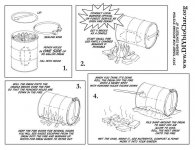Ya the char is a sponge for whatever you add and for whatever microbes are looking to colonise the airspaces in the char.
I have heard some mention of char made from manures being a good thing... but i have no idea if they are retaining their NPK. I have read for instance that corn cobs are very high in potassium and this is retained or even concentrated in the ash if burnt/charred.
For good amounts of P the organic guru whose workshop i attended advised to use a high scilica rock dust such as Azomite or his recommendation: FCRD. http://www.fcrd.com.au/
Furthermore, phosphorous fixation is a major problem. Phosphorus fixation is the process whereby added Phosphorus is not taken up by the plant because it becomes fixed in the soil. Adding a wide range of minerals helps to unlock the excess phosphorous and nitrogen and therefore making the use of traditional NPK fertilisers much more effective and efficient.
FCRD suggests to users of NPK fertilisers that they can reduce their costs by using significantly less traditional fertilisers, by adding a portion of FCRD (to release the full potential of the traditional fertilisers) and still maintain or increase yield . The upside comes from an increase in soil quality due to the addition of organic nutrients.
FCRD contains:
* Volcanic rock - 90% finer than 0.250 mm
* Silicates - Necessary in building plant protein in the cell wall. Their strengthening qualities are vital in protecting against insect and fungal attack.
* Calcium - Required for cell division and as a component of cell walls.
* Magnesium - A key part of the chlorophylls, which perform photosynthesis.
* Iron - Aids in the promotion and regulation of plant growth.
* Potassium - Strengthens plant stalks
* Phosphorous - Energy food for plants
* Trace Minerals - Plant growth can suffer without these. FCRD contains over 70 macro and micronutrients not found in commercial NPK fertilisers.
The average composition of FCRD expressed as oxides is:
SiO2 43%
Fe2O3 13%
Al2O3 13%
MgO 11%
CaO 9%
Na2O 2%
TiO2 2%
K2O 2%
As elements, the average composition is:
Silicon 22%
Iron 11%
Aluminium 8%
Calcium 7%
Magnesium 6%
Sodium 2%
Titanium 2%
Potassium 1%
I have heard some mention of char made from manures being a good thing... but i have no idea if they are retaining their NPK. I have read for instance that corn cobs are very high in potassium and this is retained or even concentrated in the ash if burnt/charred.
For good amounts of P the organic guru whose workshop i attended advised to use a high scilica rock dust such as Azomite or his recommendation: FCRD. http://www.fcrd.com.au/
Furthermore, phosphorous fixation is a major problem. Phosphorus fixation is the process whereby added Phosphorus is not taken up by the plant because it becomes fixed in the soil. Adding a wide range of minerals helps to unlock the excess phosphorous and nitrogen and therefore making the use of traditional NPK fertilisers much more effective and efficient.
FCRD suggests to users of NPK fertilisers that they can reduce their costs by using significantly less traditional fertilisers, by adding a portion of FCRD (to release the full potential of the traditional fertilisers) and still maintain or increase yield . The upside comes from an increase in soil quality due to the addition of organic nutrients.
FCRD contains:
* Volcanic rock - 90% finer than 0.250 mm
* Silicates - Necessary in building plant protein in the cell wall. Their strengthening qualities are vital in protecting against insect and fungal attack.
* Calcium - Required for cell division and as a component of cell walls.
* Magnesium - A key part of the chlorophylls, which perform photosynthesis.
* Iron - Aids in the promotion and regulation of plant growth.
* Potassium - Strengthens plant stalks
* Phosphorous - Energy food for plants
* Trace Minerals - Plant growth can suffer without these. FCRD contains over 70 macro and micronutrients not found in commercial NPK fertilisers.
The average composition of FCRD expressed as oxides is:
SiO2 43%
Fe2O3 13%
Al2O3 13%
MgO 11%
CaO 9%
Na2O 2%
TiO2 2%
K2O 2%
As elements, the average composition is:
Silicon 22%
Iron 11%
Aluminium 8%
Calcium 7%
Magnesium 6%
Sodium 2%
Titanium 2%
Potassium 1%








